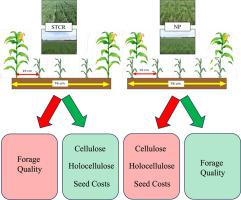当前位置:
X-MOL 学术
›
Biomass Bioenergy
›
论文详情
Our official English website, www.x-mol.net, welcomes your feedback! (Note: you will need to create a separate account there.)
Precision planting effect on winter rye yield and quality for biofuel and forage production
Biomass & Bioenergy ( IF 5.8 ) Pub Date : 2024-04-18 , DOI: 10.1016/j.biombioe.2024.107219 Katherine Baker , Sowmya Koduru , Sirwan Babaei , Oladapo Adeyemi , Garrett Williams , Shalamar Armstrong , Andrew J. Margenot , Amir Sadeghpour
Biomass & Bioenergy ( IF 5.8 ) Pub Date : 2024-04-18 , DOI: 10.1016/j.biombioe.2024.107219 Katherine Baker , Sowmya Koduru , Sirwan Babaei , Oladapo Adeyemi , Garrett Williams , Shalamar Armstrong , Andrew J. Margenot , Amir Sadeghpour

|
Winter rye () (WR) can be harvested as a biofuel or forage crop to increase farm profitability while reducing soil erosion and mitigating nutrient loss during the fallow period in a corn ( L.)-soybean ( L.) rotation. Precision planting, in which the cash crop row is skipped (STCR) to create non-intersecting zones of WR and corn growth, has been introduced to reduce the costs associate with planting of WR and also to alleviate the negative impact of WR on following corn. We conducted five site-years of field experiments in Southern Illinois to compare the impact of STCR versus conventionally planted (intersecting rows of WR with cash crop; NP) WR on biomass, biofuel and forage quality, and economic benefits (potential savings in seed costs with potential for increase in quality of biomass for sale). Our results indicated that STCR had a similar leaf area index (LAI) (1.96) and biomass yield (2.52 Mg ha) to NP (1.72 and 2.33 Mg ha, respectively). Cellulose and holocellulose (cellulose + hemicellulose) concentrations of WR, which are associated with higher ethanol production, were increased by STCR relative to NP. However, hemicellulose and lignin concentrations were similar between the two planting methods. The STCR decreased forage quality potentially through increased tillering due to the reduction in seeding rate by skipping the cash crop row. Relative forage quality (RFQ) was decreased by the STCR as compared to NP. However, the RFQ in STCR was high enough (>151) that did not influence its economic value. Thus, we recommend STCR over NP for biofuel and forage production.
中文翻译:

精准种植对用于生物燃料和饲料生产的冬季黑麦产量和质量的影响
冬季黑麦 (WR) 可作为生物燃料或饲料作物收获,以提高农场盈利能力,同时减少玉米 (L.)-大豆 (L.) 轮作休耕期间的水土流失和养分损失。精准种植,即跳过经济作物行 (STCR),以形成 WR 和玉米生长的非交叉区域,以降低与 WR 种植相关的成本,并减轻 WR 对后续玉米的负面影响。我们在伊利诺伊州南部进行了五个站点年的田间实验,以比较 STCR 与传统种植(WR 与经济作物交叉行;NP)WR 对生物量、生物燃料和饲料质量以及经济效益(可能节省种子成本)的影响具有提高待售生物质质量的潜力)。我们的结果表明,STCR 与 NP 具有相似的叶面积指数 (LAI) (1.96) 和生物量产量 (2.52 Mg ha)(分别为 1.72 和 2.33 Mg ha)。 WR 的纤维素和全纤维素(纤维素+半纤维素)浓度与较高的乙醇产量相关,相对于 NP,STCR 增加了 WR 的纤维素和全纤维素(纤维素 + 半纤维素)浓度。然而,两种种植方法之间的半纤维素和木质素浓度相似。 STCR 可能会由于跳过经济作物行而导致播种率降低而增加分蘖,从而降低饲料质量。与 NP 相比,STCR 降低了相对饲料质量 (RFQ)。然而,STCR 中的 RFQ 足够高(>151),这并没有影响其经济价值。因此,对于生物燃料和饲料生产,我们建议使用 STCR 而不是 NP。
更新日期:2024-04-18
中文翻译:

精准种植对用于生物燃料和饲料生产的冬季黑麦产量和质量的影响
冬季黑麦 (WR) 可作为生物燃料或饲料作物收获,以提高农场盈利能力,同时减少玉米 (L.)-大豆 (L.) 轮作休耕期间的水土流失和养分损失。精准种植,即跳过经济作物行 (STCR),以形成 WR 和玉米生长的非交叉区域,以降低与 WR 种植相关的成本,并减轻 WR 对后续玉米的负面影响。我们在伊利诺伊州南部进行了五个站点年的田间实验,以比较 STCR 与传统种植(WR 与经济作物交叉行;NP)WR 对生物量、生物燃料和饲料质量以及经济效益(可能节省种子成本)的影响具有提高待售生物质质量的潜力)。我们的结果表明,STCR 与 NP 具有相似的叶面积指数 (LAI) (1.96) 和生物量产量 (2.52 Mg ha)(分别为 1.72 和 2.33 Mg ha)。 WR 的纤维素和全纤维素(纤维素+半纤维素)浓度与较高的乙醇产量相关,相对于 NP,STCR 增加了 WR 的纤维素和全纤维素(纤维素 + 半纤维素)浓度。然而,两种种植方法之间的半纤维素和木质素浓度相似。 STCR 可能会由于跳过经济作物行而导致播种率降低而增加分蘖,从而降低饲料质量。与 NP 相比,STCR 降低了相对饲料质量 (RFQ)。然而,STCR 中的 RFQ 足够高(>151),这并没有影响其经济价值。因此,对于生物燃料和饲料生产,我们建议使用 STCR 而不是 NP。
















































 京公网安备 11010802027423号
京公网安备 11010802027423号